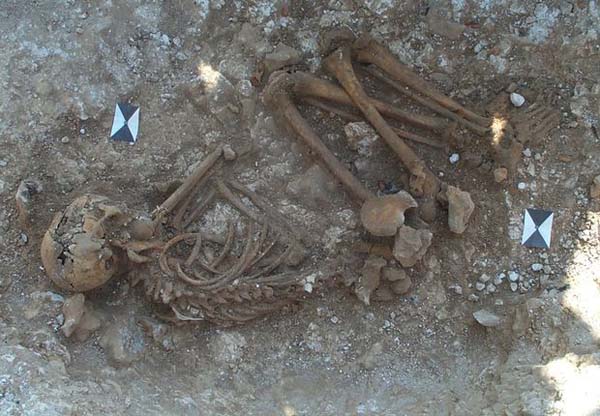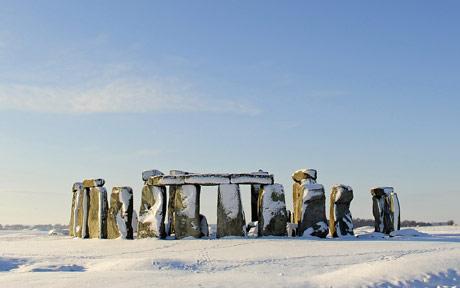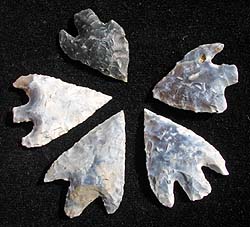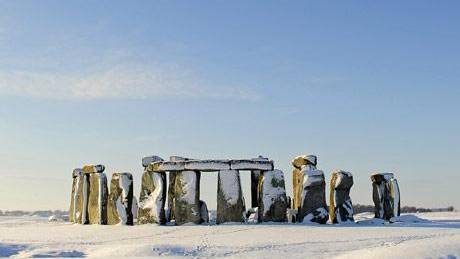The Boy with the Amber Necklace: Stonehenge skeleton came from Mediterranean
Source: theglobeandmail.com

A wealthy young teenager buried near Britain’s mysterious Stonehenge monument came from the Mediterranean hundreds of miles away, scientists said Wednesday, proof of its importance as a travel destination in prehistoric times.
The teen — dubbed “The Boy with the Amber Necklace” because he was unearthed with a cluster of amber beads around his neck — is one of several sets of foreign remains found around the ancient ring of imposing stones, whose exact purpose remains unknown.
The British Geological Survey’s Jane Evans said that the find, radiocarbon dated to 1,550 B.C., “highlights the diversity of people who came to Stonehenge from across Europe,” a statement backed by Bournemouth University’s Timothy Darvill, a Stonehenge scholar uninvolved with the discovery.
“The find adds considerable weight to the idea that people traveled long distances to visit Stonehenge, which must therefore have had a big reputation as a cult center,” Mr. Darvill said in an e-mail Wednesday. “Long distance travel was certainly more common at this time than we generally think.”
The skeleton, thought to be that of a 14- or 15-year-old, was unearthed about three kilometres southeast of Stonehenge, in southern England.
Clues to the adolescent’s foreign origins could be found in the necklace, which isn’t a recognized British type. But he was traced to the area around the Mediterranean Sea by a technique known as isotope analysis, which in this case measured the ratio of strontium and oxygen isotopes in his tooth enamel.
Different regions have different mixes of elements in their drinking water, for example, and some of those are absorbed into a person’s tooth enamel as he or she grows up. Analysis of the isotopes of oxygen and strontium carried in the enamel can give scientists a good but rather general idea of where a person was raised.
The teen, whose necklace suggests he came from a rich family, is one of several long-distance travelers found near Stonehenge. The “Amesbury Archer,” so-called because of the stone arrowheads he was found with, was buried five kilometres from Stonehenge but is thought to have from the Alpine foothills of central Europe. The “Boscombe Bowmen,” also found nearby, are thought to have come from Wales or possibly Brittany.
It isn’t clear precisely what drew these people to Stonehenge, a site which has existed in various forms for some 5,000 years. It clearly had an important ceremonial function, and the area around it is dotted with the remains of prehistoric monuments and tombs. Some say it was at the center of a sun-worshipping culture or that it served as a kind of astronomical calendar.
Others, like Mr. Darvill, also say it might have been an important healing site, drawing pilgrims from across Europe like a prehistoric version of Lourdes.
Article from: theglobeandmail.com
Buried at Stonehenge: boy with the amber necklace
By Richard Alleyne | Telegraph.co.uk

Fallen snow rests on Stonehenge on Salisbury Plain Photo: REUTERS
The teenager is believed to have been part of a wealthy group that travelled 1,600 miles from southern Europe to Britain, taking in the stone circle along the way.
His find is thought to be important because it is likely he was too young to travel on his own and was probably part of a large family group.
He is the third ancient foreigner to be found near the World Heritage Site in the last few years but the other two were grown men thought to be tradesman or warriors.
His discovery further suggests that the stone circle would have been a place of pilgrimage or sightseeing akin to a medieval cathedral as long as 4,000 years ago.
"They may have come to Britain for different reasons but Stonehenge would have been well known across Europe – rather like a medieval cathedral," said Dr Andrew Fitzpatrick, part of Wessex Archaeology who made the find.
"They may have come to trade but visited Stonehenge a long the way. It would have been an awesome sight. It would have been one of the greatest temples of its time."
The boy – aged 14 or 15 – had travelled to Britain from Spain, Italy, Greece or France, crossing the English Channel in a primitive wooden boat or canoe around 1550BC.
Unfortunately he died – probably from illness – and was buried in a primitive grave around two miles away still wearing what would have been an expensive amber necklace.
Dubbed the Boy with the Amber Necklace he is the third long distance traveller to be find near the monument since digging started at nearby Boscombe Down Airbase.
 Archaeologists have previously showed that the Amesbury Archer – a man buried with a treasure trove of copper and gold and discovered in 2002 – was born in the German Alps.
Archaeologists have previously showed that the Amesbury Archer – a man buried with a treasure trove of copper and gold and discovered in 2002 – was born in the German Alps.They also believe that the Boscombe Bowmen – a group of seven men, women and children found the following year – originated from Wales or Brittany.
All three – found buried along with dozens of locals – are thought to have been members of the elite of society as they all had valuable possessions.
The origins of the three travellers was discovered thanks to chemical analysis of their teeth which can pinpoint the climate and terrain of where they lived when they were growing up.
Professor Jane Evans, of the British Geological Survey, who carried out the research, said that she believed that the monument would have been as awe-inspiring as Westminster Abbey or the launch of a Space Shuttle.
"It must have been an incredible structure when it was built," she said. "They would have come to stare in amazement."
Mike Pitts, editor of British Archaeology, said that families and tradesmen travelling to Britain would have taken time to see Stonehenge.
"They would have made a detour to see what would have been a wonder of its time."
The boy’s virtually intact skeleton was discovered at Boscombe Down, a mile from Stonehenge, by Wessex Archaeology during a housing development.
The remains were radiocarbon dated to around 1550BC – a time when the monument was already more than 1500 years old.
Prof Evans used a slither of tooth enamel – the size of a nail clipping – to trace his origins. By analysing the ratio of two different forms or ’isotopes’ of oxygen, Prof Evans found that the boy came from a warmer climate.
And an isotopic comparison of the mineral strontium, which is absorbed by the body from plants, revealed that he came from the Mediterranean or Iberia.
Article from: telegraph.co.uk
Also tune into:
Dennis Price - The Dark Side of Stonehenge
Dennis Price - The Missing Years of Jesus
Wayne Herschel - The Hidden Records
Freddy Silva - Ancient Sacred Sites, Invisible Temples, Giants & Our Ancestors
Gary Biltcliffe - The Legacy of the Etruscans & The Mysterious Pelasgi
David Flynn - The Giant’s Geoglyphs of Tiahuanaco
David Hatcher Childress - Technology of the Gods & Ancient Atomic Warfare
David Hatcher Childress - The Mystery of the Olmecs & Ancient Civilizations
Michael Tsarion - The West to East Movement of Civilization, Land Bridges & Age of Catastrophe
Scott Wolter - The Kensington Rune Stone
Martin Doutré - Ancient Celtic New Zealand
Laird Scranton - The Science and Symbols of the Dogon
Alex Putney - Human Resonance, Sacred Sites, Pyramids & Standing Waves






















